My Spidey Sense (TM) is telling me there's a 75% chance the PTB will use this explosion/trail in Montana as a way to increase tensions with China.
You are using an out of date browser. It may not display this or other websites correctly.
You should upgrade or use an alternative browser.
You should upgrade or use an alternative browser.
Near-Earth objects and close calls
- Thread starter Gawan
- Start date
XPan
The Living Force
METEOR? CHINESE BALLOON?
MASSIVE EXPLOSION Over Billings, Montana – Military Helicopters Have Been Activated
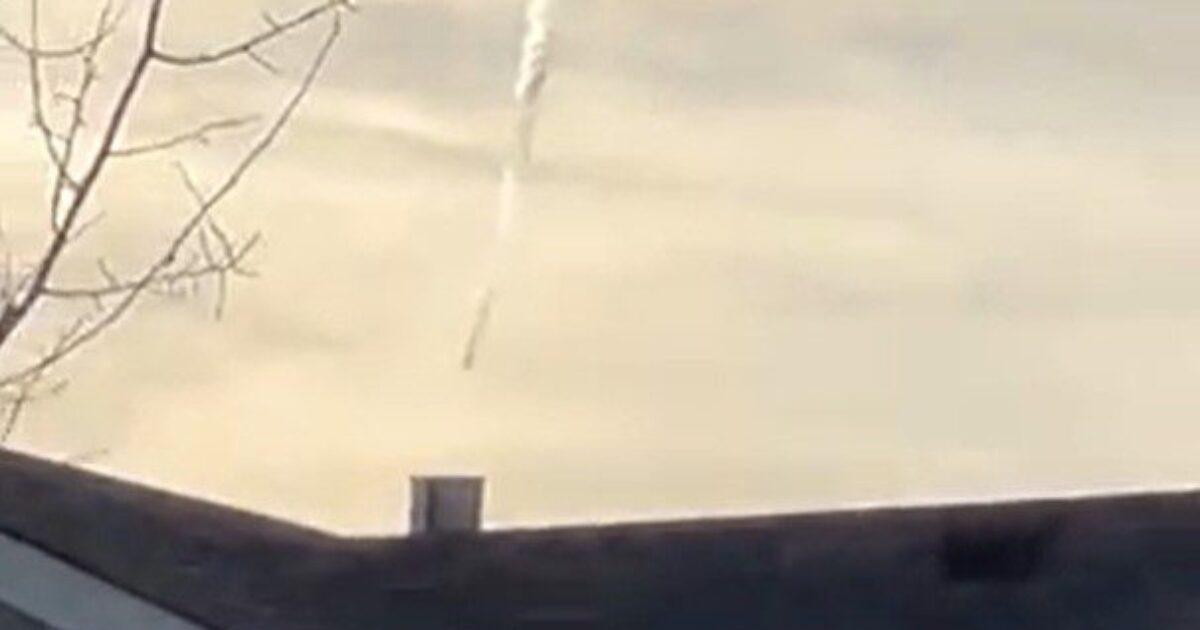
Montana Governor and Emergency Services Confirm: NO EXPLOSIONS Occurred In or Around Billings, Montana on Friday Night | The Gateway Pundit | by Jim Hoft
UPDATE — The City of Billings, Governor Gianforte, and the Montana Department of Emergency Services confirmed on Friday night that there was no explosion in or around Billings, Montana.www.thegatewaypundit.com
To me this video looked "funky", in terms of (possible) manipulation.
The condense streak itself looked like that from an airplane, and it appeared to my eye, that the plane slowly continued to move (like an airplane in a large distance / afar towards the horizon) away from the observer. The "flash" looked outmost strange and unnatural, more like somebody filled in the highlights in a couple frames, digitally dipping with white color in the highlights without "smoothing", which resulted into hard artifacts at the border to slightly darker nuances.
If this was supposed to be a "massive explosion" - why is the sound so crappy and weak ? Our mobile phones in 2023 (and past 10 years) are not this crappy anymore when it comes to sound recording ! Therefore, to me, the sound was as if somebody stomped the foot against a wooden plank or board of some kind.
I guess in this 3D realm, i am generally a sceptic in terms of presented social media videos, because I see far too people claiming things in a big way, a sort of "theatrical exaggeration" (often used in American advertising to name an example), making me take a step back from lofty claims. When on top possible photographical manipulations occurs, I often feel "you know what ? I am outta here".
Nevertheless, I am not denying that there are many things going on here on earth, which have substantial strangeness attached, plus that some things can't even be fully recorded in the way we would like to (or are used to), and that possible evidence not always is made out of our solid (3D) nature.
But I am allergic to primitive videos claiming straight on too big things, that's all.
Oh, and one more thing; if it would/could been a meteor, it certainly would have moved in a much faster way. If it left behind a smoke trail, it would be "frozen", but the tip of the trail was still moving... very slowly. Like an airplane in the greater distance.
Matty F
Jedi
Unrelated to the Montana fireball but a few days ago I saw a fireball driving to work. It was only a couple of seconds but very clear. I’m in the southeast of England. Funnily enough I saw a fireball near the same area driving home a couple of years ago. Looks like things are about to get very “rocky”.
I came across a great website that collects data on meteor fireball events: strewnify.com
I think it's largely drawing on American Meteor Society data, but its focus is on meteorite hunting, and for that its creator attempts calculations of the trajectories, sizes, and types/origins of the meteors.
I think it's largely drawing on American Meteor Society data, but its focus is on meteorite hunting, and for that its creator attempts calculations of the trajectories, sizes, and types/origins of the meteors.
BIG CAR #SPMN060223F LAST NIGHT IN FRONT OF #ALMERÍA at 23h48m38s TUC. This is how Antonio J. Robles
@AJ_Robles captured it from Estepa. According to @Josep_Trigo@CSIC "Of such magnitude that we studied if it could have produced seismic records or even meteorites" http://spmn.uji.es/ESP/SPMNlist.html

A previously unknown 100–200-metre asteroid — roughly the size of Rome’s Colosseum — has been detected by an international team of European astronomers using the NASA/ESA/CSA James Webb Space Telescope. Their project used data from the calibration of the Mid-InfraRed Instrument (MIRI), in which the team serendipitously detected an interloping asteroid. The object is likely the smallest observed to date by Webb and may be an example of an object measuring under 1 kilometer in length within the main asteroid belt, located between Mars and Jupiter. More observations are needed to better characterize this object’s nature and properties.
The Solar System is teeming with asteroids and small rocky bodies — astronomers currently know of more than 1.1 million of these rocky remnants of the early days of the Solar System. The NASA/ESA/CSA James Webb Space Telescope’s ability to explore these objects at infrared wavelengths is expected to lead to groundbreaking new science, but a team of scientists have shown that Webb also has an unpredicted aptitude for serendipitously detecting small and previously unknown objects.
“We — completely unexpectedly — detected a small asteroid in publicly available MIRI calibration observations,” explained Thomas Müller, an astronomer at the Max Planck Institute for Extraterrestrial Physics in Germany. “The measurements are some of the first MIRI measurements targeting the ecliptic plane and our work suggests that many, new objects will be detected with this instrument.”
The Webb observations which revealed this small asteroid were not originally designed to hunt for new asteroids — in fact, they were calibration images of the main-belt asteroid (10920) 1998 BC1, which astronomers discovered in 1998 [1], but the calibration team considered them to have failed for technical reasons due to the brightness of the target and an offset telescope pointing. Despite this, the data on asteroid 10920 were used by the team to establish and test a new technique to constrain an object’s orbit and to estimate its size. The validity of the method was demonstrated for asteroid 10920 using the MIRI observations combined with data from ground-based telescopes and ESA’s Gaia mission [2].
In the course of the analysis of the MIRI data, the team found the smaller and previously unknown interloper in the same field of view. The team’s results suggest the object measures 100–200 meters, occupies a very low-inclination orbit, and was located in the inner main-belt region at the time of the Webb observations.
“Our results show that even ‘failed’ Webb observations can be scientifically useful, if you have the right mindset and a little bit of luck,” elaborated Müller. “Our detection lies in the main asteroid belt, but Webb's incredible sensitivity made it possible to see this roughly 100-metre object at a distance of more than 100 million kilometres.”
The detection of this asteroid — which the team suspects to be the smallest observed to date by Webb and one of the smallest detected in the main-belt — would, if confirmed as a new asteroid discovery, have important implications for our understanding of the formation and evolution of the solar system. Current models predict the occurrence of asteroids down to very small sizes, but small asteroids have been studied in less detail than their larger counterparts owing to the difficulty of observing these objects. Future dedicated Webb observations will allow astronomers to study asteroids smaller than 1 kilometer in size, providing the necessary data to refine our models of the solar system's formation.
What’s more, this result suggests that Webb will also be able to serendipitously contribute to the detection of new asteroids. The team suspect that even short MIRI observations close to the plane of the Solar System will always include a few asteroids, most of which will be unknown objects.
In order to confirm that the object detected is a newly discovered asteroid, more position data relative to background stars is required from follow-up studies to constrain the object’s orbit.
“This is a fantastic result which highlights the capabilities of MIRI to serendipitously detect a previously undetectable size of asteroid in the main belt,” concluded Bryan Holler, Webb support scientist at the Space Telescope Science Institute in Baltimore, USA. “Repeats of these observations are in the process of being scheduled, and we are fully expecting new asteroid interlopers in those images!”
Notes
[1] The main asteroid belt is a doughnut-shaped region which contains the majority of the Solar System’s asteroids. It lies roughly between the orbits of the planets Mars and Jupiter, and is closely aligned with the ecliptic plane, the plane of the Earth’s orbit around the Sun, which is also the rough plane in which the other planets of the Solar System lie.
[2] ESA's Gaia mission is in the process of precisely measuring the positions of astronomical objects to build up an extraordinarily precise three-dimensional map of more than a thousand million stars.
More information
Webb is the largest, most powerful telescope ever launched into space. Under an international collaboration agreement, ESA provided the telescope’s launch service, using the Ariane 5 launch vehicle. Working with partners, ESA was responsible for the development and qualification of Ariane 5 adaptations for the Webb mission and for the procurement of the launch service by Arianespace. ESA also provided the workhorse spectrograph NIRSpec and 50% of the mid-infrared instrument MIRI, which was designed and built by a consortium of nationally funded European Institutes (The MIRI European Consortium) in partnership with JPL and the University of Arizona.
Webb is an international partnership between NASA, ESA and the Canadian Space Agency (CSA).
"Asteroids seen by JWST-MIRI: Radiometric size, distance, and orbit constraints", by T.G. Muller et al., is published in Astronomy & Astrophysics.
@AJ_Robles captured it from Estepa. According to @Josep_Trigo@CSIC "Of such magnitude that we studied if it could have produced seismic records or even meteorites" http://spmn.uji.es/ESP/SPMNlist.html
A previously unknown 100–200-metre asteroid — roughly the size of Rome’s Colosseum — has been detected by an international team of European astronomers using the NASA/ESA/CSA James Webb Space Telescope. Their project used data from the calibration of the Mid-InfraRed Instrument (MIRI), in which the team serendipitously detected an interloping asteroid. The object is likely the smallest observed to date by Webb and may be an example of an object measuring under 1 kilometer in length within the main asteroid belt, located between Mars and Jupiter. More observations are needed to better characterize this object’s nature and properties.
The Solar System is teeming with asteroids and small rocky bodies — astronomers currently know of more than 1.1 million of these rocky remnants of the early days of the Solar System. The NASA/ESA/CSA James Webb Space Telescope’s ability to explore these objects at infrared wavelengths is expected to lead to groundbreaking new science, but a team of scientists have shown that Webb also has an unpredicted aptitude for serendipitously detecting small and previously unknown objects.
“We — completely unexpectedly — detected a small asteroid in publicly available MIRI calibration observations,” explained Thomas Müller, an astronomer at the Max Planck Institute for Extraterrestrial Physics in Germany. “The measurements are some of the first MIRI measurements targeting the ecliptic plane and our work suggests that many, new objects will be detected with this instrument.”
The Webb observations which revealed this small asteroid were not originally designed to hunt for new asteroids — in fact, they were calibration images of the main-belt asteroid (10920) 1998 BC1, which astronomers discovered in 1998 [1], but the calibration team considered them to have failed for technical reasons due to the brightness of the target and an offset telescope pointing. Despite this, the data on asteroid 10920 were used by the team to establish and test a new technique to constrain an object’s orbit and to estimate its size. The validity of the method was demonstrated for asteroid 10920 using the MIRI observations combined with data from ground-based telescopes and ESA’s Gaia mission [2].
In the course of the analysis of the MIRI data, the team found the smaller and previously unknown interloper in the same field of view. The team’s results suggest the object measures 100–200 meters, occupies a very low-inclination orbit, and was located in the inner main-belt region at the time of the Webb observations.
“Our results show that even ‘failed’ Webb observations can be scientifically useful, if you have the right mindset and a little bit of luck,” elaborated Müller. “Our detection lies in the main asteroid belt, but Webb's incredible sensitivity made it possible to see this roughly 100-metre object at a distance of more than 100 million kilometres.”
The detection of this asteroid — which the team suspects to be the smallest observed to date by Webb and one of the smallest detected in the main-belt — would, if confirmed as a new asteroid discovery, have important implications for our understanding of the formation and evolution of the solar system. Current models predict the occurrence of asteroids down to very small sizes, but small asteroids have been studied in less detail than their larger counterparts owing to the difficulty of observing these objects. Future dedicated Webb observations will allow astronomers to study asteroids smaller than 1 kilometer in size, providing the necessary data to refine our models of the solar system's formation.
What’s more, this result suggests that Webb will also be able to serendipitously contribute to the detection of new asteroids. The team suspect that even short MIRI observations close to the plane of the Solar System will always include a few asteroids, most of which will be unknown objects.
In order to confirm that the object detected is a newly discovered asteroid, more position data relative to background stars is required from follow-up studies to constrain the object’s orbit.
“This is a fantastic result which highlights the capabilities of MIRI to serendipitously detect a previously undetectable size of asteroid in the main belt,” concluded Bryan Holler, Webb support scientist at the Space Telescope Science Institute in Baltimore, USA. “Repeats of these observations are in the process of being scheduled, and we are fully expecting new asteroid interlopers in those images!”
Notes
[1] The main asteroid belt is a doughnut-shaped region which contains the majority of the Solar System’s asteroids. It lies roughly between the orbits of the planets Mars and Jupiter, and is closely aligned with the ecliptic plane, the plane of the Earth’s orbit around the Sun, which is also the rough plane in which the other planets of the Solar System lie.
[2] ESA's Gaia mission is in the process of precisely measuring the positions of astronomical objects to build up an extraordinarily precise three-dimensional map of more than a thousand million stars.
More information
Webb is the largest, most powerful telescope ever launched into space. Under an international collaboration agreement, ESA provided the telescope’s launch service, using the Ariane 5 launch vehicle. Working with partners, ESA was responsible for the development and qualification of Ariane 5 adaptations for the Webb mission and for the procurement of the launch service by Arianespace. ESA also provided the workhorse spectrograph NIRSpec and 50% of the mid-infrared instrument MIRI, which was designed and built by a consortium of nationally funded European Institutes (The MIRI European Consortium) in partnership with JPL and the University of Arizona.
Webb is an international partnership between NASA, ESA and the Canadian Space Agency (CSA).
"Asteroids seen by JWST-MIRI: Radiometric size, distance, and orbit constraints", by T.G. Muller et al., is published in Astronomy & Astrophysics.
Last edited:
Huge light over Brazil causes explosion, tremors, and turning night into day
A flash in the sky after an explosion and a tremor was seen and felt all over Cascavel in the early hours of this Tuesday (7). Many Cascavelians are frightened after the seemingly inexplicable phenomenon took over the sky.
Several Internet users reported seeing something at first in the southern region of Cascavel. Then a "rain" of people reported having had the same apparition, seen in all regions of the city and even in Santa Tereza do Oeste.
The most common reports among internet users are something similar to an illuminated ball, followed by a bang that lasted about 10 seconds. Others ask: "Was there an earthquake in Cascavel? My whole building shook.
There is still no information about what really happened, but it is common for phenomena like this to have been caused by a bolide, a type of extremely bright meteor.

 alertamundialinfo.com
alertamundialinfo.com
A flash in the sky after an explosion and a tremor was seen and felt all over Cascavel in the early hours of this Tuesday (7). Many Cascavelians are frightened after the seemingly inexplicable phenomenon took over the sky.
Several Internet users reported seeing something at first in the southern region of Cascavel. Then a "rain" of people reported having had the same apparition, seen in all regions of the city and even in Santa Tereza do Oeste.
The most common reports among internet users are something similar to an illuminated ball, followed by a bang that lasted about 10 seconds. Others ask: "Was there an earthquake in Cascavel? My whole building shook.
There is still no information about what really happened, but it is common for phenomena like this to have been caused by a bolide, a type of extremely bright meteor.

Captan enorme luz sobre Brasil causa explosión, temblores y convirtiendo la noche en día
Internautas informaron haber visto algo parecido una luz en un primer momento en la sureña región de Cascavel, Paraná, Brasil, este martes 07 de febrero del 2023.
 alertamundialinfo.com
alertamundialinfo.com
A green colored fireball with strong glow flies over Puerto Rico's skies
An impressive fireball was observed in Puerto Rico on Monday, February 6, 2023, reported the Astronomical Society of the Caribbean (SAC).
According to the institution the meteorite was a piece of the asteroid called "2001 YB5″, belonging to the "Delta Cancrids" meteor shower.
The meteor disintegrated in the atmosphere at a speed of 62,000 miles per hour and it is possible that the small fragments reached the surface over the sea.
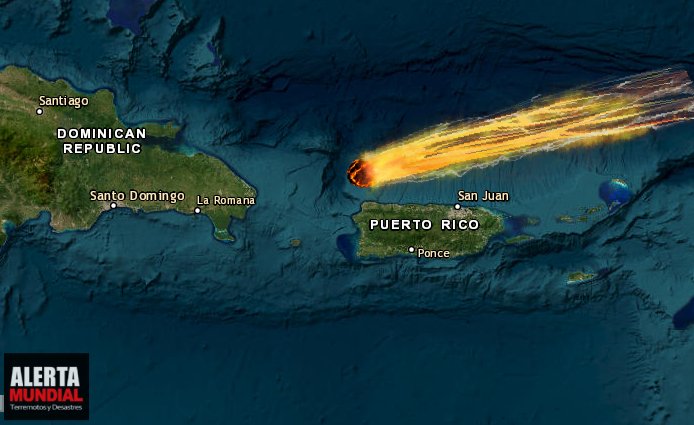
 alertamundialinfo.com
alertamundialinfo.com
An impressive fireball was observed in Puerto Rico on Monday, February 6, 2023, reported the Astronomical Society of the Caribbean (SAC).
According to the institution the meteorite was a piece of the asteroid called "2001 YB5″, belonging to the "Delta Cancrids" meteor shower.
The meteor disintegrated in the atmosphere at a speed of 62,000 miles per hour and it is possible that the small fragments reached the surface over the sea.

Una bola de fuego color verde con fuerte resplandor surca los cielos de Puerto Rico
Un impresionante bola de fuego se observó en Puerto Rico, el lunes 6 de febrero de 2023, informo la Sociedad de Astronomía del Caribe (SAC).
 alertamundialinfo.com
alertamundialinfo.com
Watch: Meteor gives brilliant green flash as it explodes over Arkansas
A large meteor lit up the skies in a brilliant green hue as it exploded over the skies of Arkansas Monday night.
Several videos have emerged from surveillance cameras and skywatchers in the region. One video shared by Twitter user @ToddAAnderson in Benton shows a huge green flash in a cloudy sky before the fireball appears to break up, according to TMX.
According to Arkansas Sky, the official Twitter account of the Arkansas SkyDome Planetarium, the green color "was likely caused by either the air glow of highly ionized atmospheric oxygen created as the meteor plowed through the atmosphere or by the burning of [copper] within the meteor itself," TMX reported.
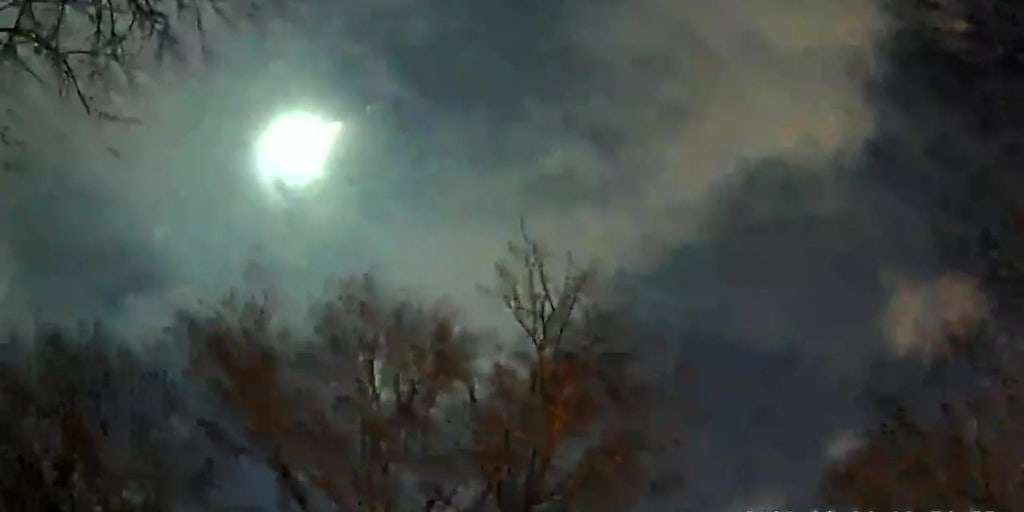
Watch: Meteor gives brilliant green flash as it explodes over Arkansas
A large meteor lit up the skies in a brilliant green hue as it exploded over the skies of Arkansas Monday night.
FIREBALLS in Japan?
This morning, a large fireball was apparently seen on Ishigaki Island, Japan, believed to have been caused by the fall of an artificial object. After examining the orbit, we believe that the fireball was caused by the fall of the orbital module of the Chinese manned spacecraft Shenzhou 12, launched on June 17, 2021. If it had been 5 minutes later, it might have been seen in Kanto area. A bit of a pity... (Translation using Deepl)
This morning, a large fireball was apparently seen on Ishigaki Island, Japan, believed to have been caused by the fall of an artificial object. After examining the orbit, we believe that the fireball was caused by the fall of the orbital module of the Chinese manned spacecraft Shenzhou 12, launched on June 17, 2021. If it had been 5 minutes later, it might have been seen in Kanto area. A bit of a pity... (Translation using Deepl)
Huge Meteorite falls with loud noise and causes vibrations in Saudi Arabia
A video clip circulating on social media documents the moment a meteorite fell in Dawadmi governorate, northwest of Riyadh.
Meteorologist Abdulaziz Al-Hussain said in a tweet, "A strong blue light appeared in the sky surrounding the meteorite in the Najd region, and a tremor was said to be felt on impact," local media report.
On the same level, the head of the Astronomical Society in Jeddah, Eng. Majed Al Zahra confirmed that this bright meteor, which is also called (the fireball), is bigger than the ordinary meteor, and drew a lot of attention on social media platforms, where many confirmed seeing it in a very bright blue color. It illuminated the earth's surface and was accompanied by a loud sound, which means that it descended very deep into the atmosphere.
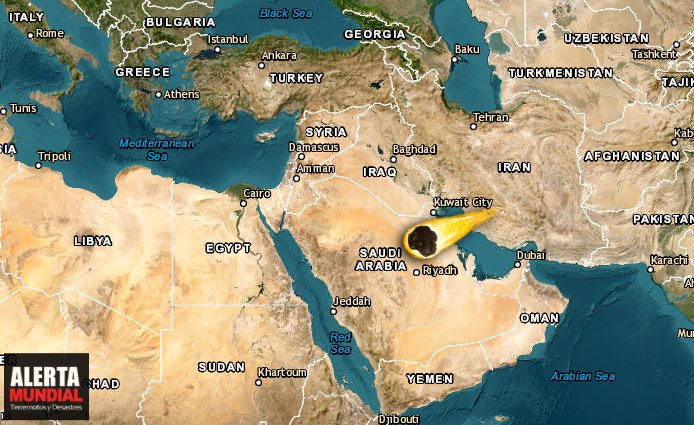
 alertamundialinfo.com
alertamundialinfo.com
A video clip circulating on social media documents the moment a meteorite fell in Dawadmi governorate, northwest of Riyadh.
Meteorologist Abdulaziz Al-Hussain said in a tweet, "A strong blue light appeared in the sky surrounding the meteorite in the Najd region, and a tremor was said to be felt on impact," local media report.
On the same level, the head of the Astronomical Society in Jeddah, Eng. Majed Al Zahra confirmed that this bright meteor, which is also called (the fireball), is bigger than the ordinary meteor, and drew a lot of attention on social media platforms, where many confirmed seeing it in a very bright blue color. It illuminated the earth's surface and was accompanied by a loud sound, which means that it descended very deep into the atmosphere.

Enorme bola de fuego explota con fuerte ruido y causa vibraciones en Arabia Saudita
Meteorito avistado en la región de Najd, Arabia Saudita, este jueves 09 de febrero del 2023.
 alertamundialinfo.com
alertamundialinfo.com
Chaze
Jedi
Can’t find much on this at the moment, but I’m reading that there’s an expected meteorite impact that’s supposed to take place over Northern France tonight.
This is what I’ve found:

This is what I’ve found:
Incoming! Almost perfectly in time for the 10 year anniversary of the Chelyabinsk meteor: The first spotted #imminentImpactor of 2023 over northern France (near Rouen)
Can’t find much on this at the moment, but I’m reading that there’s an expected meteorite impact that’s supposed to take place over Northern France tonight.
unkl brws
Dagobah Resident
Can’t find much on this at the moment, but I’m reading that there’s an expected meteorite impact that’s supposed to take place over Northern France tonight.
This is what I’ve found:
View attachment 71050
Imminent asteroid entry over the Channel on Feb.13, 02h59 UT
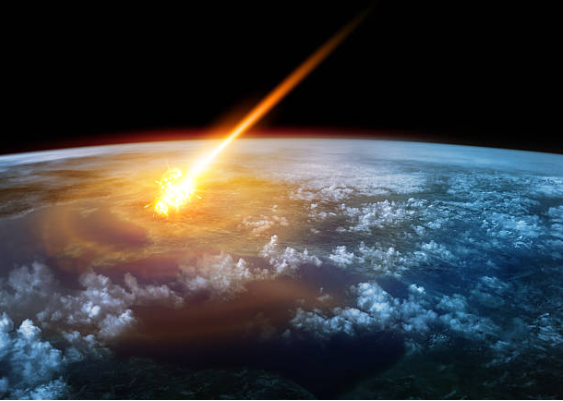
Imminent asteroid entry over the Channel on Feb.13, 02h59 UT | IMO
A freshly discovered asteroid, Sar2667 is to enter the Earth atmosphere on February 13, ~02h 59min UT over the Channel. Its small dimensions (around 1 m) means it will be the source of a bright fireball, and potential meteorites fall.
